The telomere bouquet is a hub where meiotic double-strand breaks, synapsis, and stable homolog juxtaposition are coordinated in the zebrafish, Danio rerio
- PMID: 30653507
- PMCID: PMC6336226
- DOI: 10.1371/journal.pgen.1007730
The telomere bouquet is a hub where meiotic double-strand breaks, synapsis, and stable homolog juxtaposition are coordinated in the zebrafish, Danio rerio
Abstract
Meiosis is a cellular program that generates haploid gametes for sexual reproduction. While chromosome events that contribute to reducing ploidy (homologous chromosome pairing, synapsis, and recombination) are well conserved, their execution varies across species and even between sexes of the same species. The telomere bouquet is a conserved feature of meiosis that was first described nearly a century ago, yet its role is still debated. Here we took advantage of the prominent telomere bouquet in zebrafish, Danio rerio, and super-resolution microscopy to show that axis morphogenesis, synapsis, and the formation of double-strand breaks (DSBs) all take place within the immediate vicinity of telomeres. We established a coherent timeline of events and tested the dependence of each event on the formation of Spo11-induced DSBs. First, we found that the axis protein Sycp3 loads adjacent to telomeres and extends inward, suggesting a specific feature common to all telomeres seeds the development of the axis. Second, we found that newly formed axes near telomeres engage in presynaptic co-alignment by a mechanism that depends on DSBs, even when stable juxtaposition of homologous chromosomes at interstitial regions is not yet evident. Third, we were surprised to discover that ~30% of telomeres in early prophase I engage in associations between two or more chromosome ends and these interactions decrease in later stages. Finally, while pairing and synapsis were disrupted in both spo11 males and females, their reproductive phenotypes were starkly different; spo11 mutant males failed to produce sperm while females produced offspring with severe developmental defects. Our results support zebrafish as an important vertebrate model for meiosis with implications for differences in fertility and genetically derived birth defects in males and females.
Conflict of interest statement
The authors have declared that no competing interests exist.
Figures
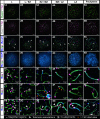
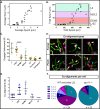


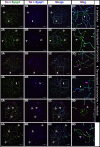
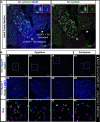



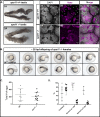

Comment in
-
It starts at the ends: The zebrafish meiotic bouquet is where it all begins.PLoS Genet. 2019 Jan 17;15(1):e1007854. doi: 10.1371/journal.pgen.1007854. eCollection 2019 Jan. PLoS Genet. 2019. PMID: 30653505 Free PMC article. No abstract available.
Similar articles
-
Synaptonemal complex extension from clustered telomeres mediates full-length chromosome pairing in Schmidtea mediterranea.Proc Natl Acad Sci U S A. 2014 Dec 2;111(48):E5159-68. doi: 10.1073/pnas.1420287111. Epub 2014 Nov 17. Proc Natl Acad Sci U S A. 2014. PMID: 25404302 Free PMC article.
-
A surge of late-occurring meiotic double-strand breaks rescues synapsis abnormalities in spermatocytes of mice with hypomorphic expression of SPO11.Chromosoma. 2016 Jun;125(2):189-203. doi: 10.1007/s00412-015-0544-7. Epub 2015 Oct 6. Chromosoma. 2016. PMID: 26440409 Free PMC article.
-
Mutations that affect meiosis in male mice influence the dynamics of the mid-preleptotene and bouquet stages.Exp Cell Res. 2006 Nov 15;312(19):3768-81. doi: 10.1016/j.yexcr.2006.07.019. Epub 2006 Aug 2. Exp Cell Res. 2006. PMID: 17010969
-
A bouquet of chromosomes.J Cell Sci. 2004 Aug 15;117(Pt 18):4025-32. doi: 10.1242/jcs.01363. J Cell Sci. 2004. PMID: 15316078 Review.
-
DNA double strand break repair, chromosome synapsis and transcriptional silencing in meiosis.Epigenetics. 2010 May 16;5(4):255-66. doi: 10.4161/epi.5.4.11518. Epub 2010 May 16. Epigenetics. 2010. PMID: 20364103 Review.
Cited by
-
Chromosome-nuclear envelope tethering - a process that orchestrates homologue pairing during plant meiosis?J Cell Sci. 2020 Aug 12;133(15):jcs243667. doi: 10.1242/jcs.243667. J Cell Sci. 2020. PMID: 32788229 Free PMC article. Review.
-
Achiasmatic meiosis in the unisexual Amazon molly, Poecilia formosa.Chromosome Res. 2022 Dec;30(4):443-457. doi: 10.1007/s10577-022-09708-2. Epub 2022 Dec 2. Chromosome Res. 2022. PMID: 36459298 Free PMC article.
-
Conserved meiotic mechanisms in the cnidarian Clytia hemisphaerica revealed by Spo11 knockout.Sci Adv. 2023 Jan 27;9(4):eadd2873. doi: 10.1126/sciadv.add2873. Epub 2023 Jan 27. Sci Adv. 2023. PMID: 36706182 Free PMC article.
-
Meiotic Chromosome Dynamics in Zebrafish.Front Cell Dev Biol. 2021 Oct 8;9:757445. doi: 10.3389/fcell.2021.757445. eCollection 2021. Front Cell Dev Biol. 2021. PMID: 34692709 Free PMC article. Review.
-
Identification of fish spermatogenic cells through high-throughput immunofluorescence against testis with an antibody set.Front Endocrinol (Lausanne). 2023 Apr 3;14:1044318. doi: 10.3389/fendo.2023.1044318. eCollection 2023. Front Endocrinol (Lausanne). 2023. PMID: 37077350 Free PMC article.
References
-
- Hunter N. Meiotic recombination In: Aguilera A, Rothstein R, editors. Molecular Genetics of Recombination. Berlin, Heidelberg: Springer Berlin Heidelberg; 2007. p. 381–442.
Publication types
MeSH terms
Substances
Associated data
Grants and funding
LinkOut - more resources
Full Text Sources
Other Literature Sources
Molecular Biology Databases

